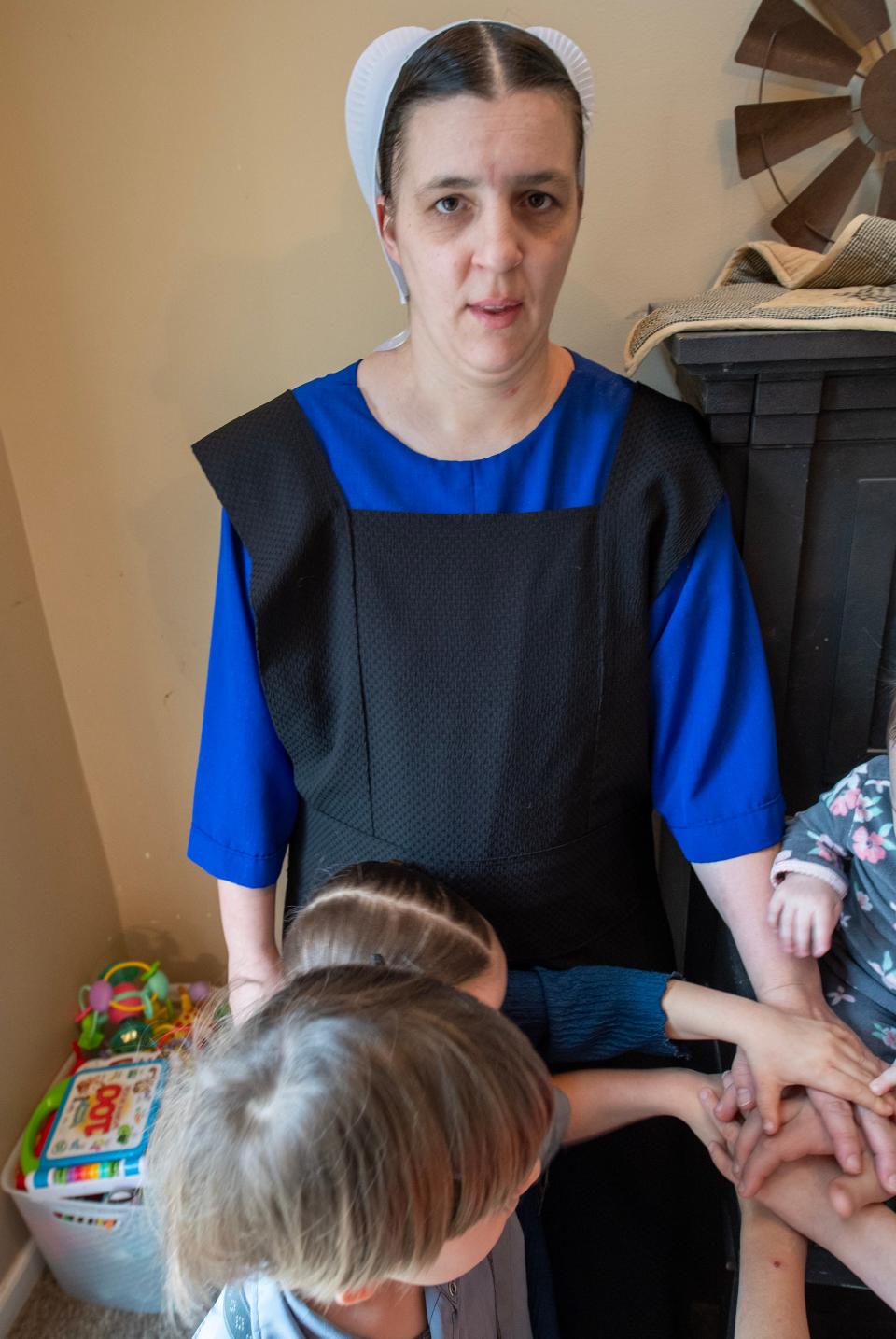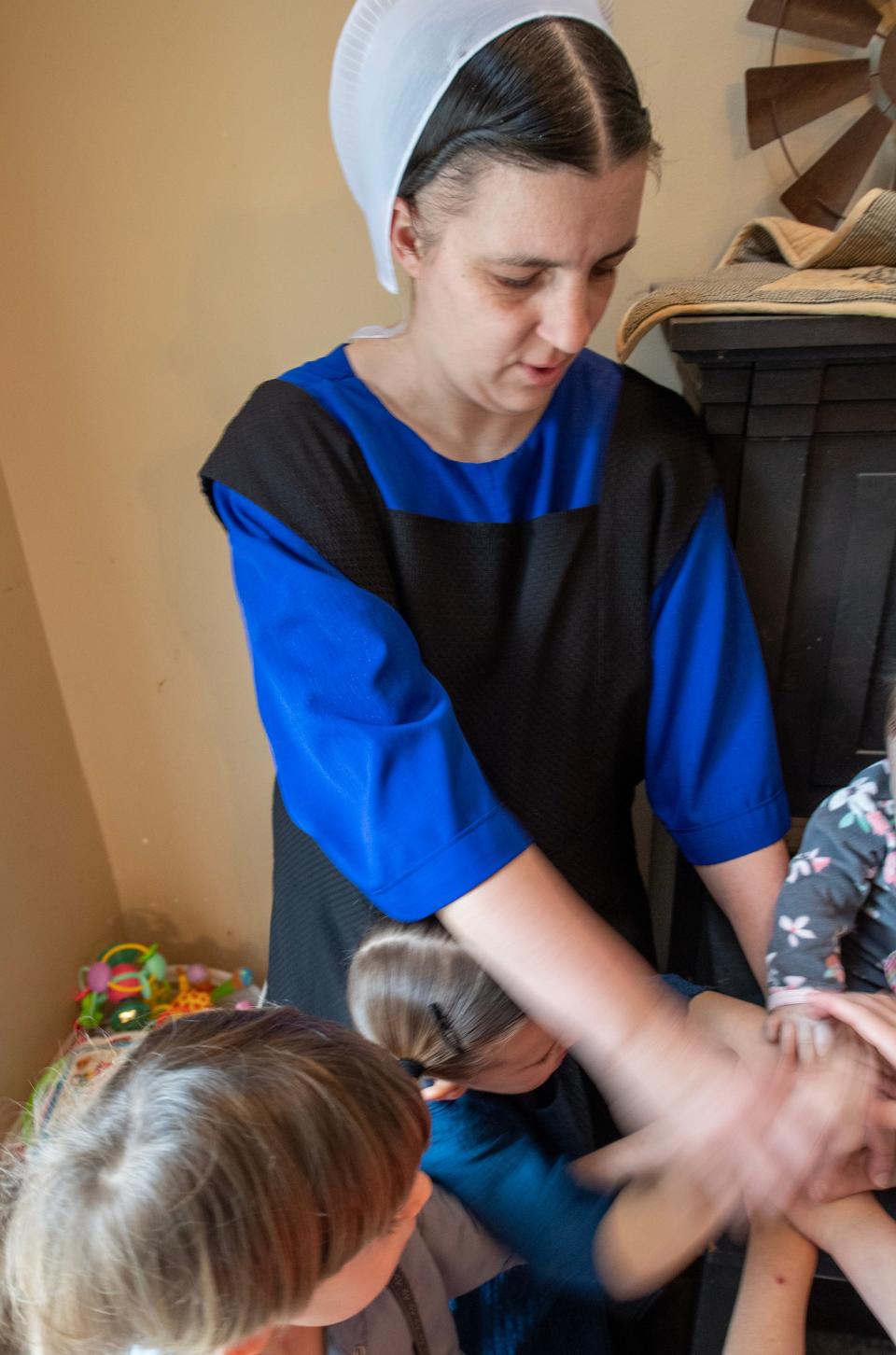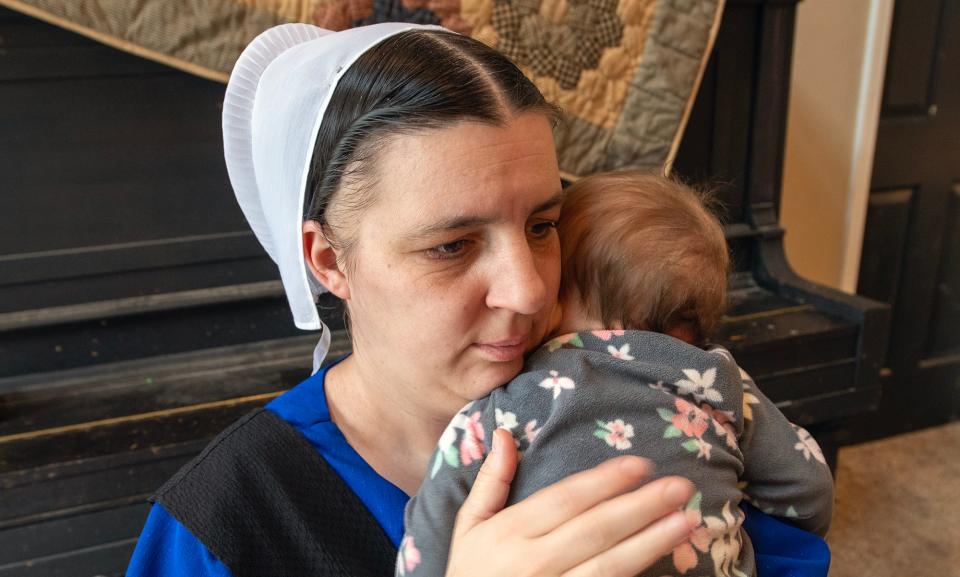Amish woman's bid to reclaim her children opens window on community-initiated separations
GAP, Pa. — The standoff at the white Amish farmhouse began as a late September sun was just dipping below the horizon.
Lydia Stoltzfus estimates she spent about a half-hour rooted in the Lancaster County home’s entryway, her arms enfolded around her 9-year-old daughter. The girl had been staying there for several months, rarely able to speak with her mom, and Stoltzfus had arrived that evening intent on reclaiming her child.
But she says two Plain women who lived there intervened, grabbing the girl from the other side and trying to pull her deeper into the home as Stoltzfus tried to work her way toward the exit. A photo from the encounter shows the 9-year-old sandwiched between adults, her brow puckered in a slight frown and arms pinned against the sides of her simple purple dress.
They stood there, deadlocked, until police arrived and gave Stoltzfus permission to leave with her daughter.
The young girl and her siblings had been moved away from their parents in late May at the direction of leaders in their Amish church, and Stoltzfus said she’d gotten limited information about the reason for the split or when her children would return home. Finally, exasperated, Stoltzfus had decided to resist her community and reunite her family on her own.
Stoltzfus’ decision to buck authority in this way is unusual within the Amish church, especially for a woman, according to former members of Plain communities.
Church-initiated family separations, though, are not as uncommon — a source of concern to advocates who worry that these cloistered communities are putting kids at risk by splitting them from their parents without legal authority or outside accountability.
“When you have (groups) operating without any real outside sets of eyes, and it’s all just whatever we want to do, that can become very problematic and even abusive very, very quickly,” said Hope Anne Dueck, executive director of A Better Way, an Ohio-based advocacy organization that works with Amish and Mennonite people.

Dueck is among the Plain advocates who say they’re aware of multiple parents who have relinquished their children or agreed to enter a religious residential facility under pressure from the church. In addition to wanting to follow the tenets of their faith and acquiesce to leadership, these families are often afraid of spiritual, relational and financial consequences if they put up a fight, she said.
Coupled with lack of understanding about their legal rights, she said, these factors can leave parents feeling powerless as their children are shuttled to different homes or, at times, to different states.
But in Dueck’s experience, law enforcement and other officials are sometimes hesitant to intervene in situations involving Amish people, preferring to give the communities — whose population totals about 90,000 in Pennsylvania and 84,000 in Ohio, according to Elizabethtown College — leeway to settle disputes on their own. And many parents are unwilling to request help from authorities directly because they distrust the government, she said.
In Stoltzfus’ case, she said she thought community members were assuming the care of her five children to give her a temporary respite while she was pregnant with her sixth child. It was weeks, she said, before she began to suspect they had other intentions.
Her husband, Benuel Stoltzfus, has accused his wife in court documents of “snatching” the children in secret and moving to Lancaster County to evade an abuse investigation in Chester County, where the family had lived. He also asserted that the children are in “immediate and ongoing danger” with their mother and objected to the older kids missing their Amish schooling.
Benuel Stoltzfus' attorney did not respond to requests for comment.
Lydia Stoltzfus said she can’t be accused of snatching her children, since they were already out of the home. Her older children are now enrolled in a virtual charter school, she said, and she’s homeschooling a third.
She acknowledges that a child welfare agency did look into reports that she had behaved inappropriately, but she produced department letters — dated more than a week before she reclaimed her children — indicating the cases were deemed unfounded and had been closed.
Diane Burkholder, who is a Plain advocate and lived in a horse-and-buggy Mennonite group until about seven years ago, said churches can employ family separations as a way to pressure parents who aren’t conforming to community expectations.
“We’re taking the children, and we’re holding them like a carrot in front of the mom,” said Burkholder, who has allowed Stoltzfus and her children to live in her Lancaster County home for the past several months. “And (we’re) saying, ‘You can’t have this until you meet my measure.’”
One of the Amish men involved in Stoltzfus' case declined to comment on specifics, except to say there's "more to the story than is being told." The Lancaster County man — who requested that he be publicly identified only by his last name, Stoltzfoos — acknowledged that some custody and child welfare situations get mishandled in the Amish community but says that's often due to chaos within the family rather than decisions by church elders.
'They knew I was under stress'
The offer came unexpectedly to Stoltzfus, but at 8½ months pregnant it sounded like a welcome reprieve.
A support team of couples from her Amish community volunteered, she said, to take on the care of her five children for a period of time, moving them to different homes in the Plain community while Stoltzfus was preparing to give birth and adjusting to life with a new infant.
In June, Stoltzfus, 35, delivered a girl. But in the weeks that followed, she said the removal of her children began to feel like more than just a respite.
Now she sees it as a calculated move, based on an array of community concerns about the couple’s marriage and parenting.
“They knew I was under stress,” she said. “And they figured that's the way they can get the children.”
During this time, reports were made to local child welfare officials, alleging that Stoltzfus had behaved inappropriately with two of her children. Church members told her she couldn’t see the two children for weeks, and forbade her from speaking even with their caretakers as the investigation unfolded, she said.
According to a custody case filed by Stoltzfus’ husband, the support team had expected to reunite the family after the baby was born. However, those plans ground to a halt when the allegations surfaced, according to his complaint.
The Chester County Department of Children, Youth and Families looked into both accusations and closed them after ruling them unfounded because “(1) the incident did not occur, (2) the injury was not of a serious nature, or (3) substantial evidence was not found,” according to Sept. 19 letters that Stoltzfus received from the agency and shared with the USA TODAY Network.
She said that officials called her in mid-August to notify her that the case had been closed and followed up with the letter several weeks later. Even then, Stoltzfus said, there didn’t seem to be an end in sight to the family separation, and there was little understanding of why the kids still couldn't come home.
She says the church support team, who’d been assigned to help Stoltzfus and her husband through marital difficulties, at one point told them they’d have to work on their relationship before they’d be reunited with their children.
They recommended that the couple enter an eight-month unlicensed residential program that had a waitlist of about a year, according to Stoltzfus. She wasn’t willing to split her family for that long.

Her sister, Mattie King, who is formerly Amish, said she tried to help Stoltzfus figure out why her children were being withheld from her, even making contact with church members involved in the situation. According to King, they wouldn’t answer questions about why they’d taken the children, what their plan was and when they’d be open to reuniting the family.
“I was like, these kids need to get back together,” she said. “It’s not good for kids, for a family, to be ripped apart like that.”
One evening in late September, after roughly four months apart from her kids, Stoltzfus says she decided she’d waited long enough for permission to reclaim them. She was going to pick her children up herself.
Several of her non-Amish family members volunteered to drive her to the various homes where her children were staying, starting with her 9-year-old daughter in Lancaster County.
After the standoff there, visits to the other homes went more smoothly, although not without some pushback from caretakers, Stoltzfus said. Within a few days, she had pieced her family back together — and in doing so, she had divided herself from the community where she’s spent her life.
Handling child welfare issues
Dueck agrees there are appropriate circumstances for taking a child out of the home for their own safety.
But she worries that leaders in the Amish community are not equipped to handle many of these cases, lacking the appropriate expertise and outside accountability.
Sometimes, individuals within churches are stepping in to advise families experiencing challenges. In more extreme situations, such as those involving abuse reports, regional committees called Conservative Crisis Intervention, or CCI, teams might get involved.
As Stoltzfus understands it, her church support team planned the initial removal of her children. A regional CCI group, whose members Stoltzfus didn’t know, entered the picture after the Children and Youth Services reports, she says.
These groups were created with the goal of establishing a liaison between secular authorities and Amish community members, said Stoltzfoos, a representative of the CCI team that covers Lancaster, York and Chester counties. While agreeing to use only his last name, the USA TODAY Network corroborated his identity.
"To help our people understand that the law is here to help them protect them also," he said, adding that there are several dozen such teams working in Pennsylvania alone.
Dueck said she was initially open to the idea that Amish crisis teams might build bridges between Plain communities and outside authorities, but as time has gone on, she's become concerned about how they work in practice.
These teams can wield significant decision-making power within their communities, Dueck said. They can advise that children be removed from their parents or that people move into unlicensed Amish and Mennonite mental health facilities to live for weeks or even months.
The CCI teams are typically all-male, Dueck said, and have little or no training in best practices for handling abuse cases or family law situations.
While government child welfare officials, whom Plain communities often distrust, are far from perfect, they answer to a system of checks and balances, she said. The teams, she said, can act as if they are beyond accountability.
In addition, some of the reasons support groups or crisis teams might try to split children from parents wouldn’t necessarily make sense to outsiders, with different notions of what qualifies as unacceptable behavior, according to Burkholder.
Stoltzfoos acknowledged this, noting that, for instance, though pornography is legal, it's also not tolerated by the Amish.
With these communities enforcing strict modesty standards, women and girls are held responsible for their style of dress, and a mother might even draw criticism for nursing her infant too openly, according to Burkholder. A rocky marriage might also provide justification for dividing children from their parents, said Burkholder, who believes that these separations initiated without court order or professional guidance can become tools of coercion.
“It’s not OK to have these assigned foster homes without any legal grounding and then decide if the marriage is in a good place to give those kids back or not,” she said, adding that she has witnessed firsthand the trauma this approach has caused Stoltzfus' children.

While Stoltzfoos said the groups' mission is to streamline interactions with officials, Sasha Sheridan, a detective with the Clinton County District Attorney’s Office, worries that CCI groups might sometimes block appropriate abuse reporting.
“These (CCI) teams, what they’re doing is they are looking to not get law enforcement involved,” said Sheridan, who has spent years learning about Amish and Mennonite communities and leads training seminars on child abuse prevention among Plain people.
Stoltzfoos says CCI members are male but make sure a woman is present during any interactions with females. The teams do operate within an Amish accountability structure, he said, and can't make significant decisions — such as whether to split up a family — without consulting with a bishop or other ministry leaders.
He said the crisis groups work collaboratively with local authorities, meeting a couple times a year with law enforcement and child welfare officials to maintain open lines of communication.
"We're not here to fight the law," he said. "Even though I think CCI might get accused sometimes that we're here to protect and hide, we're not."
King, Stoltzfus’ sister, said Amish support groups can be useful, explaining that her own parents had benefited from the care they received through their church. The problem, she said, arises when these groups and the crisis intervention teams resort to stripping children from their families.
“Pulling families apart, taking kids from parents and placing them with childless couples or individually in separate homes … I don’t think that’s the way to go at all,” she said.
‘This is a 50/50’
While separating children from parents isn’t unheard of in the Plain community, Stoltzfus’ decision to consult with custody attorneys and reclaim her kids is unusual, Dueck said.
Parents in Plain communities don’t always understand their custody rights or the resources at their command if their child is taken from them. Instead, she said they’re raised to submit to church authority, even when it conflicts with their instincts about their child’s well-being.
“I think if they really did understand what the laws were and what their legal rights were, I do think more of them would stand up and say, ‘No, you can't do this,’” Dueck said.
Since regathering her children, Stoltzfus has been living with a non-Amish Lancaster County family as she navigates a custody dispute with her husband. She initially pressed her case in Lancaster County, but a judge dismissed it because she’d only recently moved there, and her husband countered by filing a complaint in Chester County courts soon thereafter.
Not only did she go against the wishes of the CCI and her support team, but she’s also resisting her husband in a community that teaches women to submit to their spouses. Stoltzfus said the support group from her church communicated primarily with her husband, and she didn’t personally know the members of the intervention team that was exerting influence in her case, so she also had limited ability to interact with them.
However, Stoltzfus said she used her own interpretation of the Scriptures as her guide, even as her children’s caretakers insisted custody decisions fell to her husband first.
“Listen, I cannot read anywhere in the Bible that a husband has more custody over children than a wife,” Stoltzfus said. “I’m like, this is a 50/50.”
Stoltzfus’ decision to take her children back has resulted in her removal from good standing in her congregation, she said.
Dueck said these types of experiences illustrate why many parents acquiesce to church mandates.
Elders can use shaming to punish someone who steps out of line, rebuking them publicly or forcing them to confess in front of a congregation, according to Dueck. A more extreme step would be excommunication, or expulsion from the community, a measure that cuts people off from their social network and could even destroy someone’s livelihood.
Sheridan said people from a secular background might struggle to understand how difficult it is to walk away or defy Amish community leaders. She compared being shunned to having all your economic and social stability crumble overnight.
“If you were thrown out of your house with zero, what would you do?” she said. “Most of us have friends that we can call and talk to, but if they're shunned, they have nobody.”
Stoltzfus said she’s unsure whether she wants to reintegrate into her Amish community, but she has no interest in returning while the church is treating her as a pariah.
The courts in December awarded Stoltzfus’ husband partial custody of their children. She retains primary custody.
This article originally appeared on Beaver County Times: How do Amish communities handle child welfare concerns?

